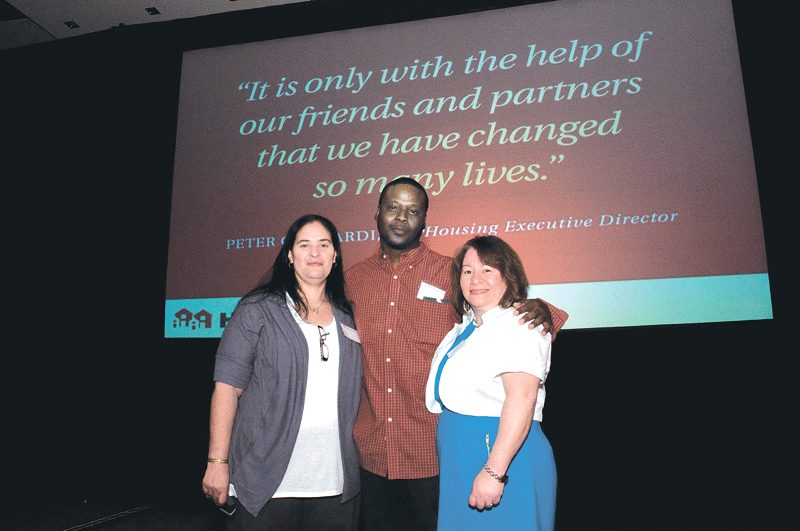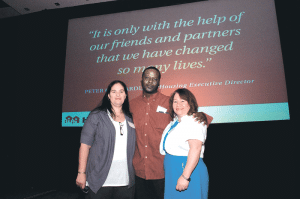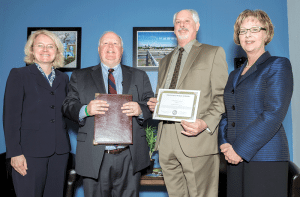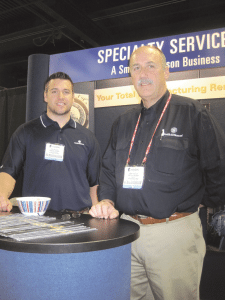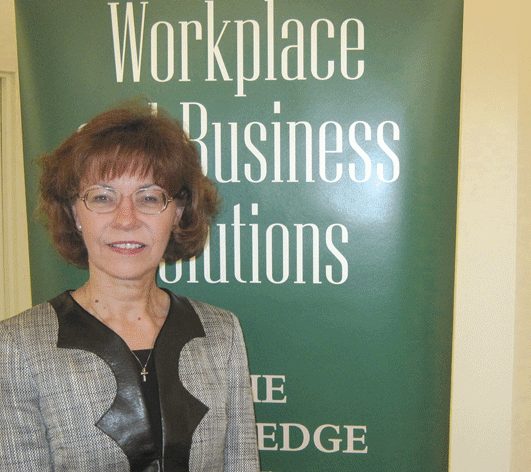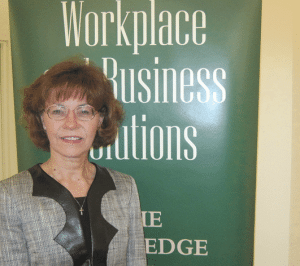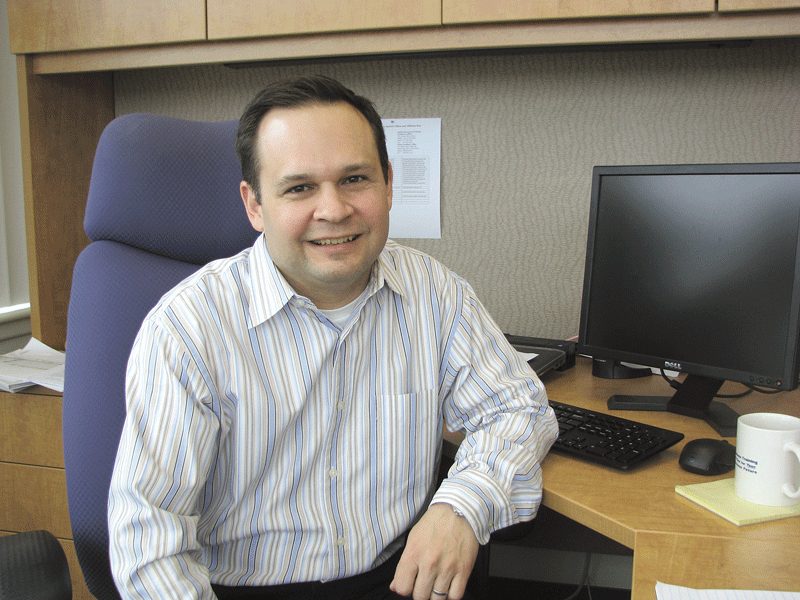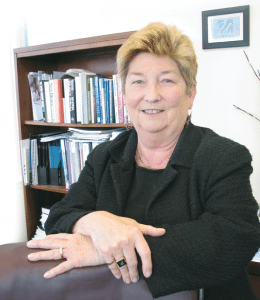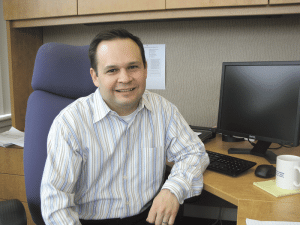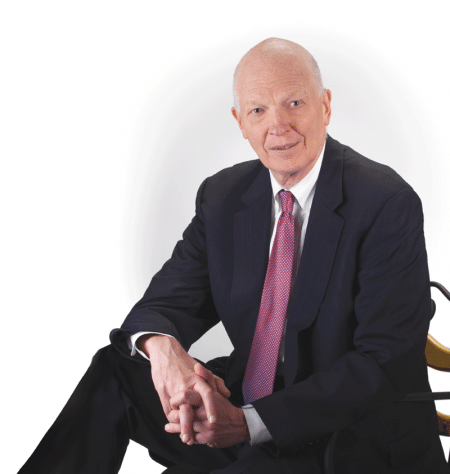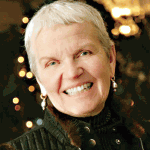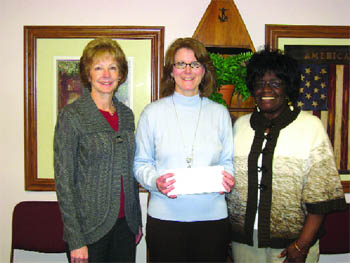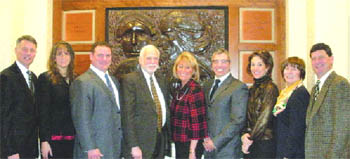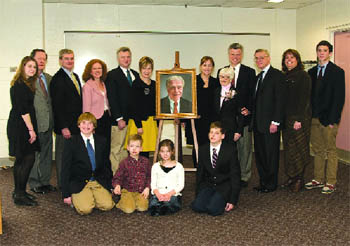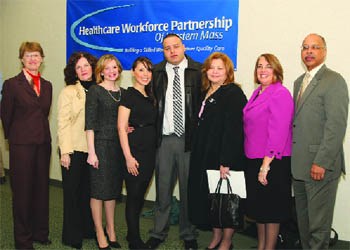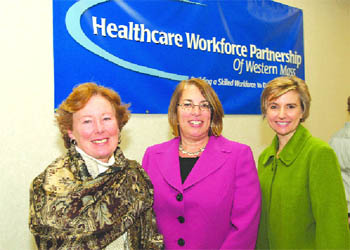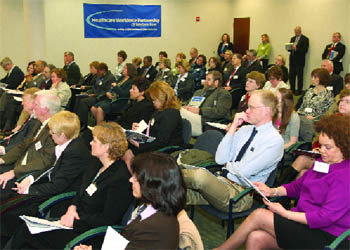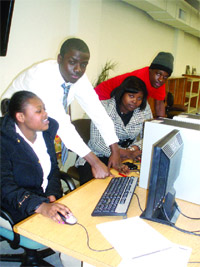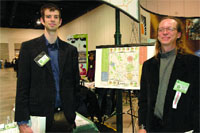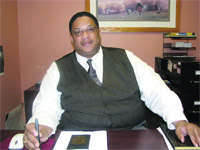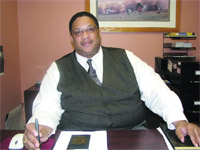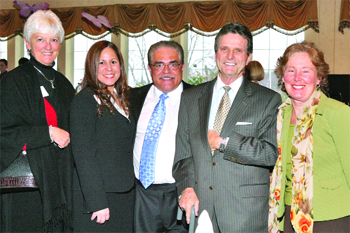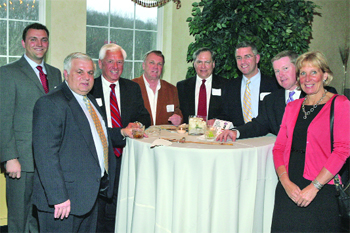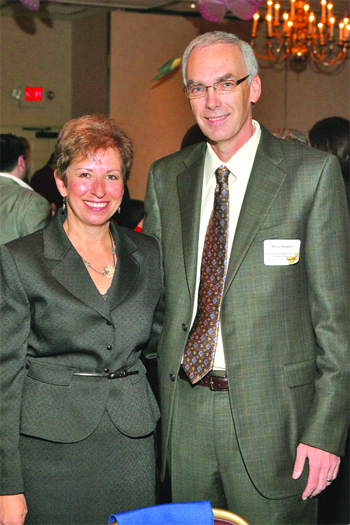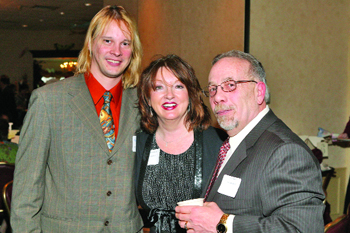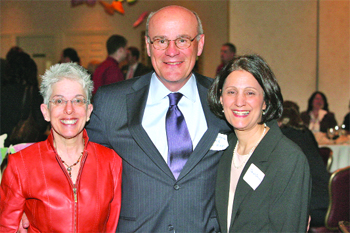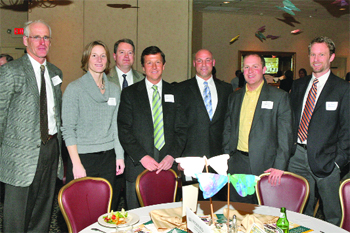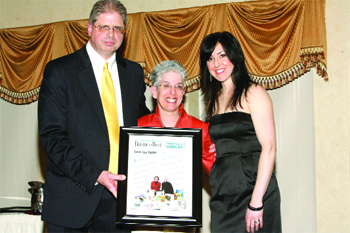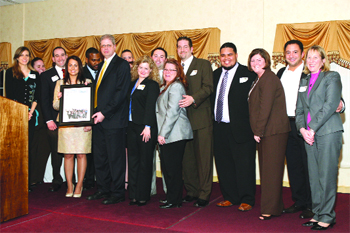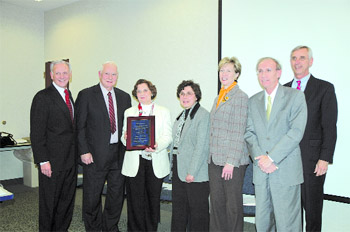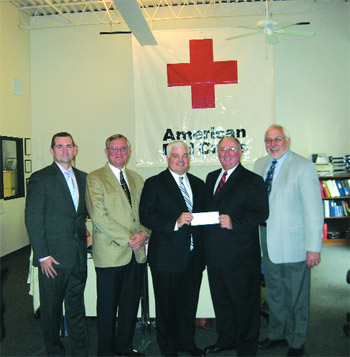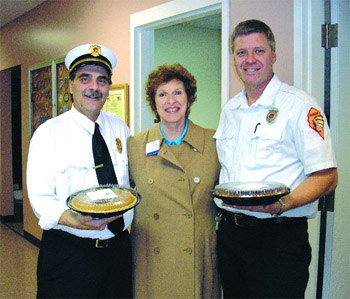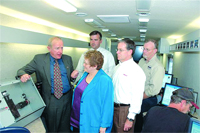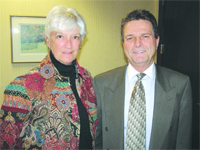REB’s New Director Wants to Build on Recent Momentum

Dave Cruise says one of his priorities is to continue the employment board’s tradition of innovation in tackling regional workforce-development issues.
Dave Cruise’s desk — or, more specifically, what sits on it — speaks volumes about his work with the Regional Employment Board of Hampden County, and also his work ethic and his passion for putting other people to work.
Sitting in one corner are a few “toys,” as he calls them, including a plastic device (a tracheal tube of sorts once made by Mitchell Machine in Springfield), as a well as a small plastic castle tower, complete with an interior staircase, that are there as reminders of the many different types of products made in this region and of the high degree of precision involved with such work.
There’s also his personal pair of safety goggles, given to him by officials at Hoppe Technologies in Chicopee, which have been put to great use over the years as Cruise has carried out his assignment as project director of the REB’s Precision Manufacturing Regional Alliance Project, as well as a pair of earplugs, which haven’t been used much at all, by his recollection, because he likes to listen.
And then, there’s the paperwork.
It covers all but a few square inches of desk, credenza, and connecting leaf that is home to his computer monitor. It has become the stuff of legend in this agency, and Cruise can readily joke about it.
“People who know me would say my desk actually looks pretty clean today,” he said with a laugh as he talked with BusinessWest on the last day of 2013. “It may look cluttered, but it’s organized; I know where everything is, trust me.”
Hopefully he can say the same thing in a few weeks after he moves everything next door, to the much larger office assigned to the REB’s president, a post he officially assumed late in the afternoon on Jan. 2 as Bill Ward closed the book on a more-than-30-year stint at the helm of the agency.
Cruise’s new desk will likely become even more cluttered than the old one because there is much work to do in the weeks and months ahead — and for the time being, he won’t be naming a new project director of the Precision Manufacturing Regional Alliance Project.
“I’m going to be very careful about what our budget looks like moving forward into FY 15 so that we have the resources to be able to do what we need to do here. Before I add staff, I want to make sure we can sustain that staff,” he explained, adding that, while he’ll be keeping some of his former responsibilities with that program, he’ll also be parceling others out to different staff members.
In the meantime, he will also be leading the work to draft a new strategic plan for the REB. The previous, three-year document sunsetted at the end of the year, he explained, adding that, under normal circumstances, a new one would certainly have been in place by now, but the search for a new director — and Ward’s insistence that his successor be involved with writing a new plan — changed the timetable.
Cruise will bring to his new position a wide range of experience in workforce development and education, including a lengthy stint as director of the Mass. Career Development Institute (MCDI) and a host of assignments with Springfield Public Schools, as well as some specific skills and management techniques he’s developed over a 45-year career.
“My training has always been in workforce development, so I feel very comfortable moving from what I would describe as a sectoral initiative in manufacturing to seeing that sectoral initiative as part of the REB’s broader mission around workforce development and job creation,” he explained. “I’m excited about the opportunity to come into this work; I believe I can add some value to work we’re doing here. Bill has been a pioneer, and I hope to build on what’s been accomplished. The platform is there, and my role is to come here and move that work to the next level.”
For this issue and its focus on employment, BusinessWest talked at length with Cruise about his new assignment and also about the many challenges facing both employers and those looking to join the workforce.
Moving the Pile
Cruise said that he was not initially a candidate for the president’s position when Ward officially announced he would be stepping down early last summer, primarily because he considered much of the work he was doing with the region’s manufacturing sector to be unfinished business. And he wanted to finish it, or at least stay with it.
But things changed as the search commenced, reached a point last fall where a few finalists were interviewed, and was then expanded, he explained.
“I had given it some thought during the initial process last summer, but didn’t get engaged at that point,” he explained. “I continued to give it some thought both personally and professionally when the process was expanded. I sat down with my family and talked about the work ahead, and decided to become an applicant.
“I was very much involved in the work I’m doing in manufacturing, and I’m very committed to that assignment,” he went on. “I realized that, going forward, that work is part of a broader body of work being done here at the Regional Employment Board, and that I could probably bring that work to the level that I wanted to by being in a position to influence, manage, and direct the work from a different perspective and bring some different resources to it.”
Thus, Cruise will add another line to a diverse résumé with a number of stops, all involved, in one way or another, with the broad ream of workforce development.
He started in 1967 at Springfield’s Roger L. Putnam Vocational Technical High School, where he taught English until 1973, before moving to MCDI.
He first served as supervisor, overseeing training programs for unemployed adults and youth, while also analyzing labor-market trends and assessing needs within specific sectors of the economy. He was named director in 1980 and managed the now-closed agency through one of the busiest periods in its history, managing a staff of more than 150 and training up to 550 people in day and evening division programs.
From MCDI, he moved on to Springfield Public Schools, where he served as director of Occupational Education, director of personnel, chief operations officer, and finally executive director of Human Resources.
He then worked briefly as a consultant before being tapped by Ward to be program manager of the Literacy Works of Hampden County initiative from 2004 to 2006, and then the Precision Manufacturing Regional Alliance Project.
Over the past seven years, Cruise has been putting those goggles, if not the earplugs, to good use, visiting area precision manufacturers, assessing their needs, and developing programs to put more workers in the pipeline. Among the many initiatives that have occupied his time — and space on his desk — have been efforts to introduce young people to the manufacturing sector and convince both them and their parents that it is a field with a future, not just a glorious past.
One of the more recent endeavors, launched just last fall, is a pilot program called Pathways to Prosperity in Advanced Manufacturing, or simply ‘Pathways,’ which puts ninth-grade students at West Springfield High School on a career pathway that will eventually take them to Springfield Technical Community College and then, hopefully, employment with one of the many manufacturers desperate for qualified help.
The program, which started with 40 students, involves a number of partners, ranging from the REB, STCC, and the high school to several employers in West Side and Agawam (among them Advance Welding, Hayden Corp., Ben Franklin Design & Manufacturing, and Atlantic Fasteners), as well as the Eastern States Exposition, NUVO Bank, and the Bates Fullum Insurance Agency.
Cruise counts the ability to create and sustain such partnerships as one of his greatest strengths, and he said it’s one of many skill sets he will need as he goes about the task of guiding the REB as it carries out a rather broad mission.
Overall, he views his primary job description to be both innovator and facilitator when it comes to the REB’s many initiatives.
“We have a very talented group of people here. They work very hard, and they’re very dedicated to the mission of the REB,” he told BusinessWest. “They understand the vision, the values, and the purpose of the organization. My job is to be a resource to them and provide them with the tools they need to take their work to the next level.
“My goal is to strive toward operational excellence,” he went on. “I’m very committed to making sure that we do quality work that will respond to the business needs of the companies in the area, but that we also keep focused on our commitment to the customers, the clients that we’re here to serve.”
Parts of the Whole
Cruise expects a new strategic plan to be ready for the REB’s quarterly meeting in March, if not sooner. When asked about what will likely be in it, he said it will continue to focus on the many aspects of the REB’s mission and priorities such as youth, literacy, education, and especially innovation.
That last term essentially defined Ward’s lengthy tenure as REB president, he went on, and the agency must continue to exude that quality if it is to meet the region’s many workforce challenges — and secure the public and private funds that will be needed to carry out those assignments.
“I’m committed to the notion of innovative ideas,” Cruise explained, adding that this is an important companion piece to one of the REB’s primary assignments — collecting workforce data. “It’s going to be very important to look at some of the work being done by the REB that I believe is innovative and seeing how we can scale that work up, not only across the region but perhaps across the state.”
Moving forward, he said there are several priorities for the REB that are both part of its mission and key elements for the new strategic plan. They include:
• Identifying new public and private funding sources, or, more specifically, combinations of both for various initiatives;
• Continuing and escalating programs involving literacy and, overall, the education and employability of adults;
• A focus on young people and making sure they have what Cruise called the “employability skills necessary in the 21st century,” work that involves everything from early childhood education to programs like Pathways;
• Work to deepen and broaden relationships with area businesses and industry groups; and
• Being an advocate for workforce development as economic development, or, as Cruise put it, “telling our story.”
Elaborating, he said that all of these concepts, or strategic initiatives, are interrelated, and as an example, he said that workforce-development-related agencies (like the REB) that have good data as well as innovative ideas about what to do in response to that information, and work aggressively to tell their stories, are better-positioned to secure funding for such initiatives.
“It’s going to be those organizations and those agencies that have good data, have good strategic plans, have a clear mission, and then have the talent to pull it off, that are going to be able to get funding moving forward,” he explained. “I’m very committed to operational excellence here at the REB; I want to make sure that we’re doing quality work and that our work defines us, because I believe that if we can make that case and share it with people, especially with this notion of innovation and innovative ideas, that money will follow.
“I don’t think you can go out today and simply make an ask,” he continued, referring to requests for state and federal funds that are in shorter supply than years ago, as well as private money from businesses and foundations. “You simply need to demonstrate that you can add value to what that ask is all about.”
As for that goal of deepening and broadening relationships with industry groups and specific businesses, Cruise said this assignment involves both telling the REB’s story and, more importantly, listening to what those in various sectors are saying about what they’re seeing today — and expect to see tomorrow.
“I want to deepen those relationships, but I also want to engage more business and industry in different sectors in the work we’re doing,” he said. “I’m going to try to spend a reasonable amount of time out in the community. I want to go out and listen and learn; I want to see how people who are familiar with our work perceive us, and for people who are not familiar with the work we do, I want to build a relationship and a partnership with them.”
Work in Progress
When asked about the particular strengths he believes he brings to the table, Cruise put “relationship building and partnership building” at the very top of the list.
“I’m a good listener, and I believe in convening and facilitating,” he said, adding that these are qualities that will serve him well as he goes about the task of not only continuing to carry out the REB’s broad mission, but also building a tradition of innovation.
He said he has the commitment — and the desk space — to carry out his new assignment.
George O’Brien can be reached at [email protected]






